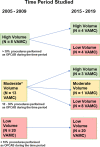Off-Pump Coronary Artery Bypass Grafting: Department of Veteran Affairs' Use and Outcomes
- PMID: 35229663
- PMCID: PMC9075317
- DOI: 10.1161/JAHA.121.023514
Off-Pump Coronary Artery Bypass Grafting: Department of Veteran Affairs' Use and Outcomes
Abstract
Background Coronary artery bypass can be performed off pump (OPCAB) without cardiopulmonary bypass. However, trends over time for OPCAB versus on-pump (ONCAB) use and long-term outcome has not been reported, nor has their long-term outcome been compared. Methods and Results We queried the national Veterans Affairs database (2005-2019) to identify isolated coronary artery bypass procedures. Procedures were classified as OPCAB on ONCAB using the as-treated basis. Trend analyses were performed to evaluate longitudinal changes in the preference for OPCAB. The median follow-up period was 6.6 (3.5-10) years. An inverse probability weighted Cox model was used to compare all-cause mortality between OPCAB and ONCAB. From 47 685 patients, 6759 (age 64±8 years) received OPCAB (14%). OPCAB usage declined from 16% (2005-2009) to 8% (2015-2019). Patients with triple vessel disease who received OPCAB received a lower mean number of grafts (2.8±0.8 versus 3.2±0.8; P<0.01). The ONCAB 5-, 10-, and 15-year survival rates were 82.9% (82.5-83.3), 60.4% (59.8-61.1), and 37.2% (36.1-38.4); correspondingly, OPCAB rates were 80.7% (79.7-81.7), 57.4% (56-58.7), and 34.1% (31.7-36.6) (P<0.01). OPCAB was associated with increased risk-adjusted all-cause mortality (hazard ratio, 1.15 [1.13-1.18]; P<0.01) and myocardial infarction (incident rate ratio, 1.16 [1.05-1.28]; P<0.01). Conclusions Over 15 years, OPCAB use declined considerably in Veterans Affairs medical centers. In Veterans Affairs hospitals, late all-cause mortality and myocardial infarction rates were higher in the OPCAB cohort.
Keywords: coronary artery bypass grafting; long term survival; myocardial infarction; off‐pump surgery.
Figures



References
-
- Zhao DF, Edelman JJ, Seco M, Bannon PG, Wilson MK, Byrom MJ, Thourani V, Lamy A, Taggart DP, Puskas JD, et al. Coronary artery bypass grafting with and without manipulation of the ascending aorta: a network meta‐analysis. J Am Coll Cardiol. 2017;69:924–936. doi: 10.1016/j.jacc.2016.11.071 - DOI - PubMed
MeSH terms
LinkOut - more resources
Full Text Sources
Medical

